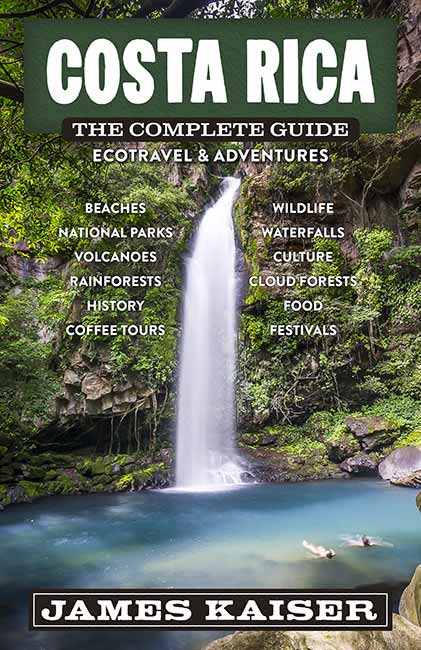
Costa Rica is famous for wildlife watching, and nesting sea turtles are one of the country’s highlights.
Although global sea turtle populations have declined by roughly 95%, Costa Rica has taken important steps to protect these magnificent creatures. On some Costa Rican beaches sea turtle populations are even increasing.
On beaches where sea turtles nest, trained guides show eco-travelers the nesting process up close. The money generated from turtle watching tours, in turn, helps fund conservation efforts.
So viewing sea turtles in Costa Rica isn’t just a beautiful experience. It also helps protect turtles!
On this page, I’ll show you Costa Rica’s best sea turtle nesting beaches. I’ll also provide links to some fantastic sea turtle volunteer opportunities.
Costa Rica Sea Turtles
Costa Rica is home to five of the world’s seven sea turtle species.

Green Sea Turtle
Green sea turtles (Chelonia mydas) measure up to 5 feet (1.5 meters) long and weigh up to 420 pounds (190 kg). Named for the green fat beneath their shells, they are the second-largest sea turtles in Costa Rica.
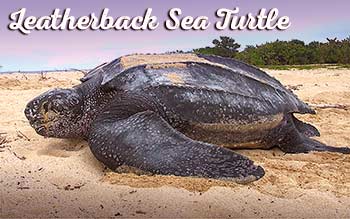
Leatherback Sea Turtle
Leatherbacks (Dermochelys coriacea) are the world’s largest sea turtles. They grow up to 10 feet (3 meters) long and weigh up to 2,000 pounds (900 kg). Instead of a hard shell, they have a soft, leathery back.
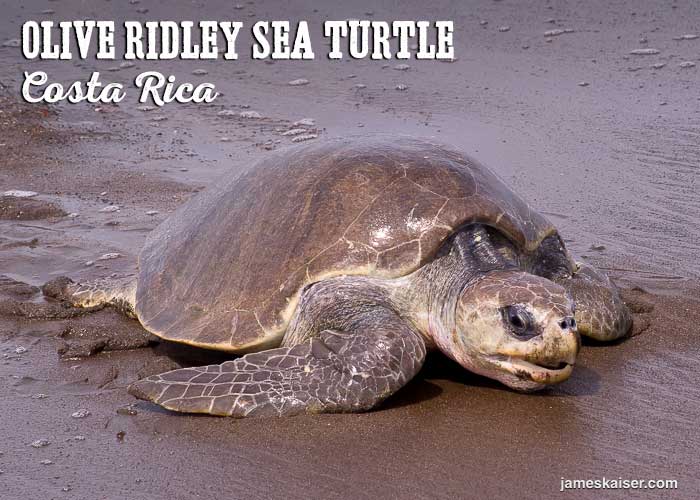
Olive Ridley Sea Turtle
Olive ridleys (Lepidochelys olivacea) are the smallest sea turtles in Costa Rica. They measure just two feet (0.6 meters) long and weigh 30 pounds (66 kg). On some beaches tens of thousands of olive ridely turtles nest at the same time.
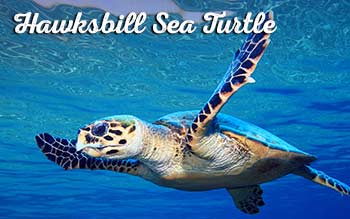
Hawksbill Sea Turtle
Hawksbill sea turtles (Eretmochelys imbricata) measure up to 2.6 feet (.8 meters) long. They were once hunted for their beautiful translucent shell, which was used to make combs, eyeglass frames and other decorative items.

Loggerhead Sea Turtles
Loggerhead sea turtles (Caretta caretta) grow up to 3 feet (1 meter) long. They have large, powerful jaws to feed on ocean invertebrates.
Sea Turtle Nesting Beaches in Costa Rica
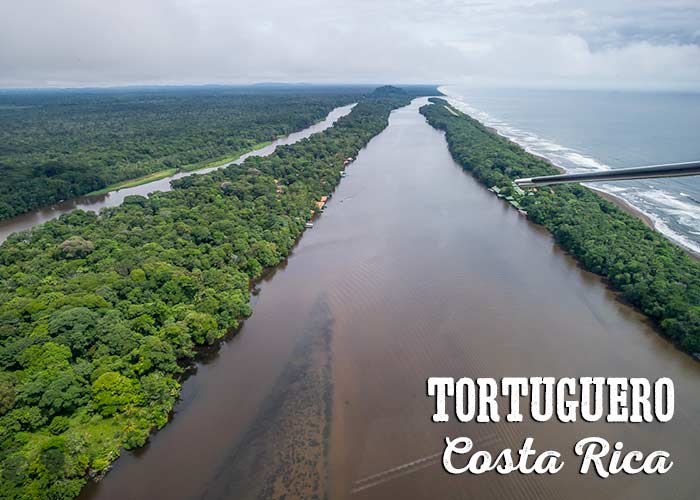
Tortuguero
For most of the 20th century, Costa Rica’s remote northwest Caribbean coast was unknown to biologists. Then, in 1953, American sea turtle researcher Archie Carr visited the village of Tortuguero (“Place of the Turtles”).
He was amazed by what he saw.
Between June and October, tens of thousands of green sea turtles lay their eggs on Tortuguero’s dark sand beaches.
Tortuguero, Carr realized, was no ordinary sea turtle nesting beach. It was the most important green sea turtle nesting beach in the Caribbean.
Carr devoted himself to protecting Tortuguero. In 1975 Costa Rica established Tortuguero National Park, and since then turtle nestings have increased nearly 500%.
Today nearly 20,000 green sea turtles nest here each year — the largest colony of nesting green turtles in the world.
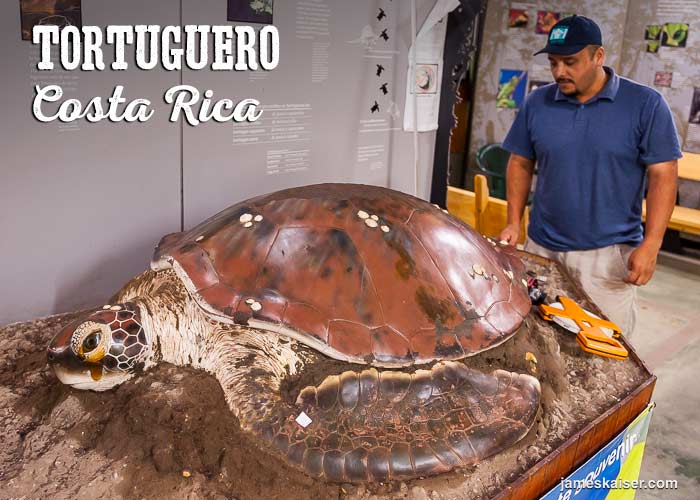
Visit during peak turtle season (July, August, September) and trained guides will show you the sea turtle nesting process up close.
Here’s how it works:
When a female green sea turtle emerges from the Caribbean, she crawls up the beach above the high tide mark. She digs a nest and lays roughly 100 eggs. During this time she goes into “trance,” and it’s ok for people to approach her with red-tinted flashlights.
During peak egg-laying season, official turtle spotters wander the beach in search of egg-laying females. When one is spotted, a trained guide is notified by walkie-talkie. The guide then takes a small group of people to watch the turtle lay eggs. The guide also ensures that the turtle remains undisturbed.
To learn more about Tortuguero turtle tours — including how to find the best guides — check out my full-color book, Costa Rica: The Complete Guide.

Ostional
Just north of Nosara on Costa Rica’s Pacific coast lies Ostional. For most of the year, there’s nothing special about this dark sand beach. Then, during rainy season, it hosts one of nature’s most extraordinary spectacles.
Once a month between July and December, thousands of olive ridley sea turtles visit Ostional at the same time to lay their eggs in the sand. This phenomenon, called an arribada, lasts 4-7 days. During an arribada Ostional is covered with thousands — sometimes tens of thousands — of olive ridley sea turtles.
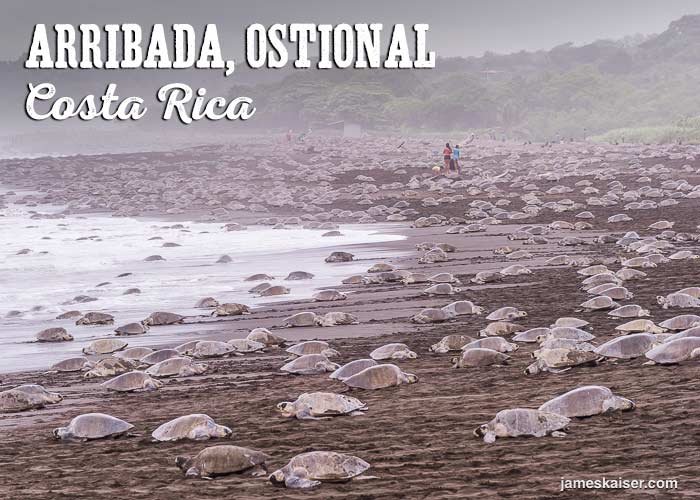
The reason for this mass nesting is unclear. But scientists believe it is a form of defense against predators. By laying hundreds of thousands of eggs, turtles overwhelm predators (such as coatis, vultures and dogs) that feed on the eggs.
Ostional’s arribadas grow progressively larger, reaching their peak in October (the depths of the rainy season). There’s no official Ostional turtle calendar; exact timing depends on the moon and the tides. But arribadas often start about a week after the full moon.
Equally impressive are the mass hatchings of baby turtles, which take place 45 – 55 days after an arribada.
Biologists first discovered Ostional’s mass turtle nestings in 1970. In 1983 Costa Rica established the Ostional Wildlife Refuge, which protects 13 miles of beaches and 19,800 acres of ocean.
To learn more about Ostional arribadas, including which companies offer the best tours, check out my full-color guidebook Costa Rica: The Complete Guide.
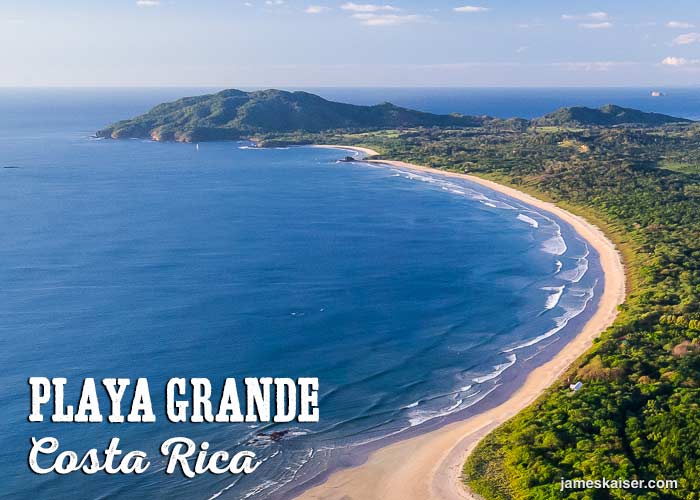
Playa Grande
Although it’s located just north of bustling Tamarindo, Playa Grande feels a world apart.
This beautiful beach stretches 2.5 miles (4 km) north of the Tamarindo estuary. During the day, it’s home to terrific surfing waves. At night, endangered eastern Pacific leatherback sea turtles lay their eggs in the sand.
To protect this critical habitat, Costa Rica established Las Baulas (“Leatherback sea turtle”) National Park in 1991. This severely restricted development at Playa Grande, keeping it in a relatively natural state.
During peak nesting season (October – February), guided turtle nesting tours are offered at Playa Grande. These tours involve waiting up to four hours for guides to spot a turtle on the beach. If a turtle is spotted, you’ll head out to the beach to watch the egg-laying process up close.
It’s important to note that turtle sightings at Playa Grande are not guaranteed. Leatherbacks are critically endangered, so not many visit the beach. Guides claim a 50% success rate during peak nesting season in December and January.
To learn more about Playa Grande leatherback nesting tours, including the best ways to book a tour and how to find reputable guides, check out my full-color guidebook Costa Rica: The Complete Guide.
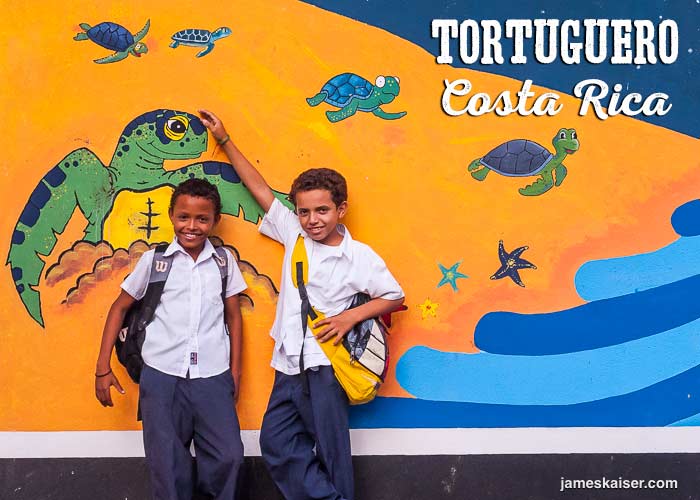
Sea Turtle Volunteering in Costa Rica
Although Costa Rica is a leader in sea turtle conservation, these magnificent animals still face numerous threats. Egg poaching, offshore fishing, and light pollution (which confuses hatchlings) to name just a few.
Fortunately, some terrific environmental organizations are working hard to protect sea turtles in Costa Rica. And several of these organizations offer volunteer sea turtle programs.
Sea Turtle Conservancy
The Sea Turtle Conservancy offer an Eco-Volunteer program in Tortuguero from June through October. Participants in the program observe the nesting process and help scientists collect data. Volunteers must be 18 or older. Discounts are available for groups of six or more. Program details.
Earthwatch
Earthwatch offers a volunteer program to help critically endangered Pacific leatherback sea turtles. Participants in the program, which runs October through January, patrol the beaches of Playa Grande, Playa Ventanas and Playa Langosta on Costa Rica’s Pacific coast. When leatherback turtles are spotted, volunteers help attach transmitters and relocate eggs to hatcheries. Program details.
Corcovado Foundation
The Corcovado Foundation offers three volunteer sea turtle programs near Corcovado National Park. With prices around $40 per day (including lodging and meals) these are among the most affordable volunteer programs in Costa Rica. Program details.
See Turtles
See Turtles offers a leatherback volunteer program near Tortuguero in June. Volunteers help scientists gather data, relocate eggs to protected hatcheries, and release hatchlings. Program details.
